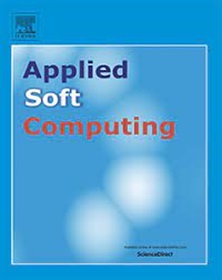融合局部密度和近似距离的非参数离群点检测
IF 6.6
1区 计算机科学
Q1 COMPUTER SCIENCE, ARTIFICIAL INTELLIGENCE
引用次数: 0
摘要
在智能数据分析中,异常点检测是一项重要而又具有挑战性的任务,一些基于密度的无监督方法被引入到低密度区域的异常点识别中。然而,这些方法仍然存在密度估计不准确和检测不同类型异常值的能力有限的问题。本文提出了一种融合密度和距离的非参数离群点检测方法(POD-FDD)。该方法采用基于自然邻域的自适应核密度估计,降低了密度估计中对参数的敏感性。此外,为了提高局部邻域密度估计的可靠性,还引入了乐观密度和悲观密度。此外,还集成了近似可达距离信息,提高了识别聚类异常点的能力。最后,提出了一种鲁棒的无参数离群点检测方法来检测不同类型的离群点。在合成数据集和公共数据集上进行了大量的对比实验和统计显著性分析,证明了其优越的性能,在AUC度量上平均提高了1.97%。本文章由计算机程序翻译,如有差异,请以英文原文为准。
Fusing local density and approximate distance for nonparametric outlier detection
Outlier detection is an essential yet challenging task in intelligent data analysis, and some density-based unsupervised methods have been introduced to identify outliers in low-density regions. However, these methods still suffer from inaccurate density estimation and limited capability in detecting diverse types of outliers. In this study, we propose a nonparametric outlier detection method with the fusion of density and distance (POD-FDD). The proposed method employs adaptive kernel density estimation based on natural neighborhoods, which reduces the sensitivity to parameters in density estimation. Moreover, the optimistic and pessimistic densities are introduced to enhance the reliability of density estimation in the local neighborhood. In addition, approximate reachability distance information is integrated to improve the capability of identifying cluster outliers. Ultimately, a robust parametric-free outlier detection method is developed to detect different types of outliers. Extensive comparative experiments and statistical significance analysis on synthetic and public datasets demonstrate its superior performance, achieving an average improvement of 1.97 % in the AUC metric.
求助全文
通过发布文献求助,成功后即可免费获取论文全文。
去求助
来源期刊

Applied Soft Computing
工程技术-计算机:跨学科应用
CiteScore
15.80
自引率
6.90%
发文量
874
审稿时长
10.9 months
期刊介绍:
Applied Soft Computing is an international journal promoting an integrated view of soft computing to solve real life problems.The focus is to publish the highest quality research in application and convergence of the areas of Fuzzy Logic, Neural Networks, Evolutionary Computing, Rough Sets and other similar techniques to address real world complexities.
Applied Soft Computing is a rolling publication: articles are published as soon as the editor-in-chief has accepted them. Therefore, the web site will continuously be updated with new articles and the publication time will be short.
 求助内容:
求助内容: 应助结果提醒方式:
应助结果提醒方式:


